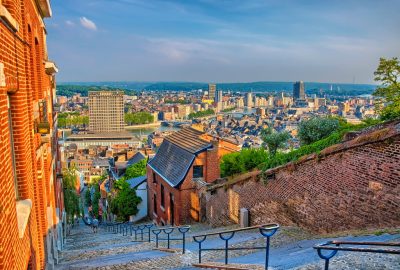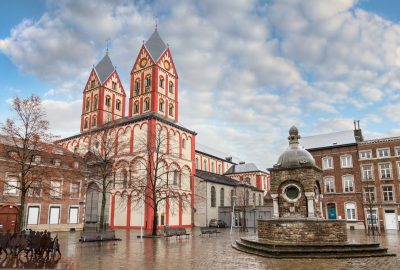You don’t go to Liège to relax. Nope. You go to Liège (or Luik in Dutch language) to get shredded. Trust me, I’m a certified personal trainer. Spend a week in Liège and your body fat % will drop to single digits. Guaranteed (terms and conditions apply)! What is it about this Liège that affects body composition so dramatically? It’s one of those cities where you stay for a few days and walk the same route. You walk around the same few blocks and it’s always a different experience. So, you do a lot of walking, because it’s very enjoyable here. Stairs are another factor that contributes to rapid fat loss. You will have to climb a lot of those if you want to see the best Liège has to offer. It is a surprisingly vertical city for this part of Europe, and this goes especially for its older parts. Montagne de Bueren is the most recognizable landmark here. It’s a whole lot of stairs leading to the top of a beautiful hill: 374 steps to be more precise. There’s a funny story involved. Troops were stationed there and their officers had trouble keeping them disciplined. The road to the city was the core of these issues. Soldiers had to navigate dim, narrow alleys “infested” with bars and prostitutes. Building this massive set of stairs to bypass the area was easier than keeping the men in check. Montagne de Bueren was built in 1881 named after a noble who defended the city in the 15th century.

Montagne de Bueren: a famous street staircase in Liege; you will need to climb 374 steps to reach the top but you will be rewarded with breathtaking city views
Traditionally, Liège has to cope with many stereotypes. It is supposed to be gloomy and unfriendly city. Many Flemish Belgians and Dutch people visiting the city have anecdotes about locals being harsh and brutal. But when you try to speak a few words of French you will notice most locals are surprisingly welcoming and warm-hearted people. According to many Dutch people Liège is a city you have to drive through as quick as possible when you are on your yearly journey towards the South of France via the Route du Soleil. And it is true that the heavy steel and coal industry dominated the city’s skyline for centuries and gave the city a grey appearance. But things changed for the better over the last years. A lot of historical buildings have been renovated and the city was also uplifted by impressive modern architecture. The new Liège-Guillemins railway station, designed by the renowned Spanish architect Santiago Calatrava, opened in 2009. It’s considered a masterpiece, constructed of steel, glass and white concrete, including a monumental arch of 160 meters long and 32 meters high.
And apart from all the new buildings Liège’s old town (Vieux Liège) hasn’t lost its charm either. Explore all the tiny alleys between residential buildings along the Montagne. Countless wonderful gardens are crammed in these nooks and crannies. Don’t get too comfortable though, it’s not a museum, people live there. The Terraces and the vantage point in the area are a great spot to rest for a bit. Sit down on a bench and take the view in. I’d love to say that it’s something unforgettable, but it’s not. Walk back down (see what I meant with all this cardio) and you’ll reach the remainder of touristy Liège. All the cool things are on, around and below the Place Saint-Lambert. It’s Liège’s main square, with the huge Prince-Bishops' Palace overlooking it. Built in 1000 CE, this building has remained the seat of power of local administration to this day. The palace might have been the residence, but the true symbol of Prince-Bishops’ rule was the Cathedral. Cathédrale Notre-Dame-et-Saint-Lambert was stunning, so much so that people compared it to the one in Paris. It stood tall for over 800 years until the French regime demolished it in 1794.
Now, we’re getting to the cool part. The ruins beneath the square are accessible to the public. It’s called the Archéoforum and it’s like a city beneath the city. What’s on display? For the most part, it’s ruins: ruins of a villa from Roman times, ruins of the Cathedral. You can watch a computer-generated presentation if you’re interested in how it used to look at its peak. The site is spread over 4000 sq. meters; there’s a lot to see there. St Paul Cathedral was built in the 15th century and took over as Liège’s main place of worship when Saint Lambert’s was demolished. Numerous artefacts have been moved here, mostly connected to St Lambert. Legend says that one of the golden ornaments has the saints’ skull inside it. There’s another secret hidden in the Cathedral: a beautiful marble statue of Lucifer. It’s a bit of a weird thing to put in a church. But that is my humble opinion. It’s a full package with bat wings, talons and horns included.

Collegiate church of St.Bartholomew: an unusually white church with red pilasters in the German-Romanesque style, one of the oldest churches in Belgium
Most people would be tired after all this walking. Guess what…there’s more walking! There are no breaks on the six-pack train. Head towards the shaded streets near the Prince-Bishops' Palace. Some of the best café’s and restaurants are in this area. Locals bake amazing pastries, especially during rhubarb season. Yum. I won’t even bother mentioning staples like the waffles or the chocolate. I will briefly mention the nightlife in Liège. Le Carré is where it’s at. Just a short walk from Place Saint-Lambert and you end up in a Belgian beer heaven. This is where all the students hang out in small pubs and bars. Le Carré reminded me of Bairro Alto in Lisbon. The riverbanks along the Meuse are an alternative. Also packed with nightlife venues, but of a slightly more mature sort. An absolute evergreen in Liège is café Aux Olivettes on Rue Pied-du-Pont-des-Arches 6. It’s a so-called Café Chantant: the French version of a karaoke café where people can climb on the stage and grab the mic or even play the piano. Especially during Sundays when the nearby famous flea market is taking place, the café is loaded with locals and tourists. Go there to see someone performing passionately Jacques Brel or Édith Piaf while you have one of those heavenly Belgian beers. After all the hard drinking and singing along you will be very hungry. And then it’s good to know that the local cuisine in Liège, as everywhere in Belgium is great. Liège is home to many Italian, Spanish and Portuguese inhabitants; progeny of the immigrants who worked in the local factories and mines long time ago. So rest assured you can choose from many outstanding Mediterranean cuisine restaurants.



No one commented yet. Be the first.